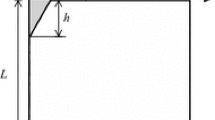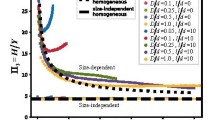Summary
The finite element method was used to simulate the conical indentation of elastic-plastic solids with work hardening. The ratio of the initial yield strength to the Young’s modulus Y/E ranged from 0 to 0.02. Based on the calculation results, two sets of scaling functions for non-dimensional hardness H/K and indenter penetration h are presented in the paper, which have closed simple mathematical form and can be used easily for engineering application. Using the present scaling functions, indentation hardness and indentation loading curves can be easily obtained for a given set of material properties. Meanwhile one can use these scaling functions to obtain material parameters by an instrumented indentation load-displacement curve for loading and unloading if Young’s modulus E and Poisson’s ratio ν are known.
Similar content being viewed by others
References
Tabor D. (1996). Indentation hardness: fifty years on – a personal view. Phil. Mag. A 74: 1207–1212
Pethica J., Hutchings R. and Oliver W. (1983). Hardness measurement at penetration depths as small as 20-nm. Phil. Mag. A 48: 593–606
Stone D., LaFontaine W., Alexopoulos P., Wu T. and Li C. (1988). An investigation of hardness and adhesion of sputter-deposited aluminum on silicon by utilizing a continuous indentation test. J. Mater. Res. 3: 141–147
Bhushan B., Kulkarni A., Bonin W. and Wyrobek J. (1996). Nanoindentation and picoindentation measurements using a capacitive transducer system in atomic force microscopy. Phil. Mag. A 74: 1117–1128
Doener M. and Nix W. (1986). A method of interpreting the data from depth-sensing indentation instruments. J. Mater. Res. 1: 601–609
Oliver W. and Pharr G. (1992). An improved technique for determining hardness and elastic modulus using load and displacement sensing indentation experiment. J. Mater. Res. 7: 1564–1583
Giannakopoulos A. and Suresh S. (1999). Determination of elastoplastic properties by instrumented sharp indentation. Scr. Mater. 40: 1191–1198
Bhattacharya A. and Nix W. (1988). Finite element simulation of indentation experiments. Int. J. Solids Struct. 24: 881–891
Laurrsen T. and Simo J. (1992). A study of the mechanics of microindentation using finite elements. J. Mater. Res. 7: 618–626
Dao M., Chollacoop N., Vliet K., Venkatesh T. and Suresh S. (2001). Computational modeling of the forward and reverse problems in instrumented sharp indentation. Acta. Mater. 49: 3899–3918
Cheng Y. and Cheng C. (1998). Scaling approach to conical indentation in elastic-plastic solids with work hardening. J. Appl. Phys. 84: 1284–1291
Cheng Y. and Cheng C. (2004). Scaling, dimensional analysis and indentation measurements. Mater. Sci. Engng. Res. 44: 91–149
Dieter G. (1976). Mechanical metallurgy, 2nd ed. McGraw-Hill, New York
Lockett F. (1963). Indentation of a rigid plastic material by a conical indenter. J. Mech. Phys. Solids 11: 345–355
Jayaraman S., Hahn G., Oliver W., Rubin C. and Bastias P. (1998). Determination of monotonic stress–strain curve of hard materials from ultra-low-load indentation tests. Int. J. Solids Struct. 35: 365–381
Zhang Z. (2003). Mastering MATLAB 6.5. BUAA Press, Beijing, p.123 (In Chinese)
Author information
Authors and Affiliations
Corresponding author
Rights and permissions
About this article
Cite this article
Feng, X.Y., Wang, T.C. Scaling functions in conical indentation of elastic-plastic solids. Acta Mech 196, 245–254 (2008). https://doi.org/10.1007/s00707-007-0479-z
Received:
Accepted:
Published:
Issue Date:
DOI: https://doi.org/10.1007/s00707-007-0479-z




